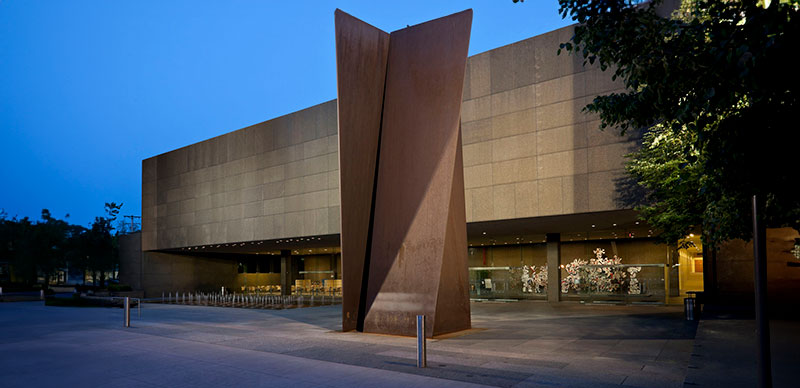The purple walls of Hanna Kilminster’s bedroom seemed to be closing in as she stared at her computer screen during online school. Some days, she recalls, out of pure boredom she would scoot out of her bed and spray-paint hearts and other doodles on one wall. She once got so bored that she shaved her head, a decision she instantly regretted. Often, she would stare out the window at the world that had been cut off from her during her junior year of high school.
One day in the spring of 2020, the 17-year-old from Portland, Oregon, decided to do an extra credit assignment for her art class—her teacher suggested submitting an image to The Andy Warhol Museum for a digital time capsule. She didn’t know much about Pittsburgh’s Pop art superstar or his compulsion to stash everyday objects away in cardboard “time capsules,” but she was excited to submit something that defined her generation, known as Gen Z. At this moment, that meant a piece of art depicting the joy-sucking claustrophobia of the COVID-19 lockdown.
She placed her Xbox controller on top of her laptop and arranged four masks on the corners of the screen and keyboard, as though they were crowding everything out. “It showed how much the pandemic was really hard on us and how the whole year we were controlled by technology,” says Kilminster, now a 19-year-old high school graduate. Like many young people, her grades and her mental health suffered as the pandemic dragged on. “I had panic attacks when I went to Walmart,” she says.
Her entry is now part of the online Gen-Z Time Capsule at The Warhol, which received 222 digital submissions. Ninety percent came from the United States, but submissions also came from Ecuador, Canada, Korea, and other parts of the world.

Hanna Kilminster, Portland, OR, Gen-Z in a Pandemic
Andy Warhol was an obsessive collector, stashing everything from newspaper headlines and source materials for work to food, photos, notes, cards, and other items into more than 600 cardboard time capsules, which are now in the care of the museum. The artist’s time capsules became a jumping-off point for other projects, including the Community Time Capsule, which documented items about local immigrant and ethnic groups, and now the Gen-Z Time Capsule.
The Gen-Z project originally was envisioned in early 2020 as a collection of physical objects from a small group of western Pennsylvania schools in partnership with The Warhol. Then the pandemic hit, and the Gen-Z Time Capsule turned digital. It spread through school districts, across social media, through peer referrals, giving voice to kids who felt silenced.
A generation speaks up
Every generation gets labeled by stereotypes, supposedly defining characteristics that lump cohorts of people together, for better or worse.
But when The Warhol reached out through social media, educators, and the media to people born between 1997 and 2012 for submissions, what emerged was a nuanced digital portrait of Gen Z, many of whom grew up in the shadow of 9/11 and all of whom lived through the pandemic and the ensuing societal upheaval.
From the Silly Bandz craze to suicidal ideation, from protest signs to a jar of porcupine quills, from All-American wrestling trophies to gender-neutral fashion, the Gen-Z Time Capsule offers an intimate and complex glimpse into the soul of a generation.

Stephanie Burritt, Bradford, PA, The Lost Soul
“It was so eye-opening and really sad in many ways how many students were submitting their thoughts on being stuck at home, the feeling of social isolation during the pandemic, and not seeing their friends,” says Nicole Dezelon, director of learning and public engagement at The Warhol. “In a way, we as a society had no idea what was really going on with Gen Z.”
Another striking trend emerged: Gen Z opened up about their mental health struggles. An entry titled The Lost Soul by Stephanie Burritt of Bradford, Pennsylvania, shows a ghostly figure standing behind a noose in a graveyard. The caption talks about the prevalence of depression in their generation. “Some may not know how to cope with it and believe that suicide is the only option to make their pain go away,” it reads.
“It was so eye-opening and really sad in many ways how many students were submitting their thoughts on being stuck at home, the feeling of social isolation during the pandemic, and not seeing their friends. In a way, we as a society had no idea what was really going on with Gen Z.” – Nicole Dezelon, director of learning and public engagement at The Warhol
John Schlimm, an artist and author who has written a book on Gen Z, collaborated with Dezelon on the project. A professor at the University of Pittsburgh at Bradford, he called this generation courageous for revealing their mental health struggles and, in the process, reducing stigma.
“By simply speaking aloud the words—anxiety, depression, suicide, I need help—they are inspiring the rest of us to also use our voices and say the words. They are gifting the world with the biggest leap forward ever in mental health awareness and advocacy,” says Schlimm, who wrote a forthcoming book titled What Would Gen-Z Do? Everything You Don’t Know About Gen-Z But Should.
All kinds of moments in time
The Gen-Z Time Capsule debunks many of the generation’s negative stereotypes. In the process of researching his book and traveling around the country to study this generation, Schlimm has heard all the bad stereotypes from parents, grandparents, teachers, and employers. Gen Z is lazy, whiny, tech-obsessed. All that talk about depression and anxiety is just a way to get out of work, and suicide is the easy way out.
But the creativity showcased in the Gen-Z Time Capsule reveals something entirely different.

Nicholas Ward, Bradford, PA, Gen-Z
“The submissions fantastically run the gamut of thought-provoking and introspective to reflective and humorously entertaining,” Schlimm says.
On the playful end were artifacts like Silly Bandz, the brightly colored rubber bands shaped like animals, guitars, and other objects, a craze that reached a crescendo in 2010 and were such a distraction that they were banned from many schools. There were also photos of family dogs and even a jar of porcupine needles that one Gen-Zer cherished, a keepsake from his late grandfather.
“The submissions fantastically run the gamut of thought-provoking and introspective to reflective and humorously entertaining.” – John Schlimm, artist and author
Much like the contents of Andy Warhol’s time capsules, Gen Z’s digital contributions grab onto both the magical and the mundane, the deeply introspective and the delightfully playful.
“It ran the gamut, the high-low culture that was so poignantly captured,” Dezelon says.

Kayla Day, Wellsville, NY, Tree with a Dog

Destiny Davis, Brookhaven, PA, Generation Z Influences

Cassea Galbreath, North East, PA, GenZ Still Life (1)
Although originally envisioned as a project with western Pennsylvania school districts, becoming digital expanded its reach to an international audience. Young people from around the globe could submit artifacts. Every time The Warhol set a deadline, other schools or homeschooling groups asked if they could submit, and Dezelon extended the deadline.
“It was so hard to close,” she said. The Warhol finally decided to cut off submissions at the end of the summer.
Unlike a typical time capsule that is hidden from view and then unveiled a decade or two later, this one went online immediately and can be found on The Warhol’s website.
“The objects they submitted capture such an important moment in time that it would be a shame to hide all of the submissions for the next 10 years,” Dezelon says. “So we are keeping it live.”
Warhol-inspired
To organize the many entries, Dezelon and Schlimm sorted them into categories—– artwork, social media, politics and current events, music, fashion, mental health, photos and selfies, animals and pets, and innovation and technology.
Abigail Mosier’s portrait of her face, with skin-tight rubber bands squeezing deep lines into the flesh, was part of the artwork category. She says the photoshoot was painful—she could only pose for 10-minute intervals while her friend took the photos. The portrait symbolizes the pressure she felt as she graduated from high school in the small town of Kersey, Pennsylvania, and told people her plans to study dance and art.

Abigail Mosier, Kersey, PA, don’t snap
“There’s just a lot of pressure when people ask you what you want to do with your life. It’s a lot of pressure about output, what you’re producing, versus how you are feeling,” says Mosier, now a 21-year-old at University of the Arts in Philadelphia. “Sometimes it’s just overwhelming. You are passionate about being an artist, and it’s not considered as valid as something like a doctor or lawyer.”
As the first generation to grow up with social media, Gen Z also faces the performative pressure of constantly projecting an ideal image online.
“There’s a lot of social pressure on showing up a certain way,” says Mosier. “And there’s this presentational exposure of ourselves, through stories on Snapchat, on Facebook, on Instagram. Sometimes I think that image of what you present is sometimes a hindrance to just living your life.”
Other submissions were direct riffs on Andy Warhol’s art. Andrew Davis-Ledesma relates to the famed artist.
“I actually go by Andy,” he says, speaking from his home in Las Vegas.

Andrew Davis-Ledesma, Las Vegas, NV, SLIPKNOT Maggot Soup
His high school art teacher would encourage his propensity to create Warholian Pop art. He saw an Instagram ad for the Gen-Z Time Capsule and decided to submit, putting his own twist on Warhol’s iconic Campbell’s Soup Cans, tweaking it to reflect his favorite heavy metal band, Slipknot, whose fans call themselves maggots.
Instead of a Campbell’s Tomato Soup can, he created a “Maggot Soup” can.
Davis-Ledesma, now a 20-year-old electrician who likes to draw, enjoys looking at the other submissions in the time capsule.
“It’s actually a great way to reach out to the art community,” he says. “It gets more people interested in trying out art and not just giving up in the first month after not seeing improvement.”
The courage of Gen Z
Some entries show that perseverance.
Jada Luther submitted two X-rays of her spine—one is of her curved back when she was diagnosed with scoliosis at age 8; the second, taken four years later after she had a spinal fusion, shows her straightened spine engineered with two rods and 17 screws.
Luther fought through her pain and limited mobility to become captain of her division 3 soccer team, even though she could barely walk after games. She eventually got so strong that she now competes in weightlifting contests.

Jada Luther, Hunt, NY, X-Ray: Before; X-Ray: After
“If I was looking at that time capsule like four years from now, it would show the pride in myself by strengthening my spine and keep pushing through and not letting surgery stop me,” she says.
Luther, now a senior at the University of Pittsburgh at Bradford, runs a mental health club on campus. Schlimm worked with the group and encouraged them to submit to the Gen-Z Time Capsule.
“Jada’s X-ray images visually exemplify how open and courageous Gen-Zers are in sharing their truths and journeys, physically and emotionally, while breaking down stigmas and stereotypes,” Schlimm says.
Though the Gen-Z Time Capsule is online now, Schlimm says it may eventually be available as a zine, preserving a written record of the creative, angsty, playful, introspective Generation Z.
The artifacts submitted to the Gen-Z Time Capsule can be viewed at https://www.warhol.org/timecapsule/gen-z-time-capsule/







